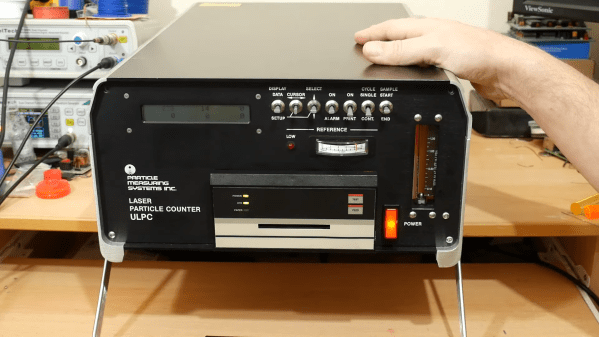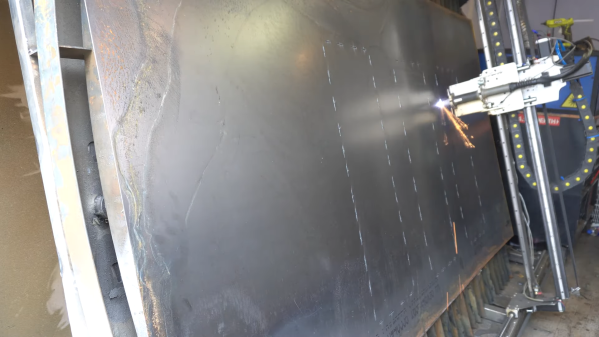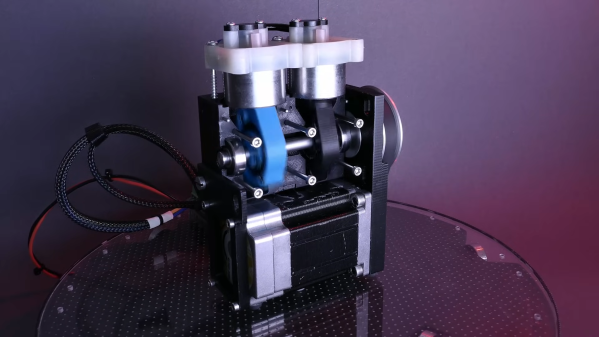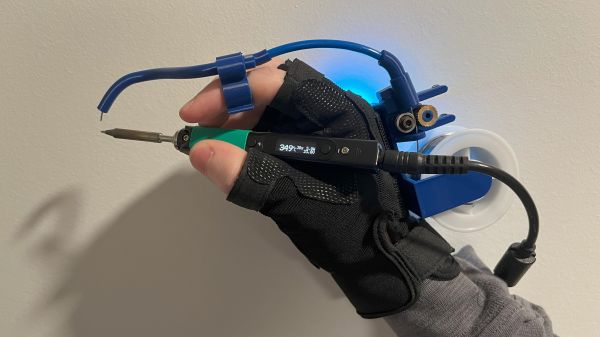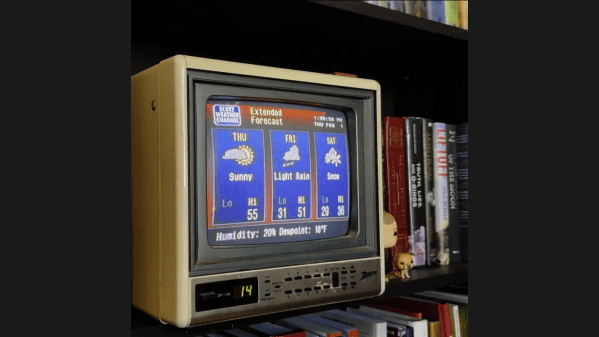The Great American Eclipse v2.0 has come and gone, sadly without our traveling to the path of totality as planned; family stuff. We did get a report from friends in Texas that it was just as spectacular there as expected, with the bonus of seeing a solar flare off the southwest limb of the disk at totality. Many people reported seeing the same thing, which makes us a bit jealous — OK, a lot jealous. Of course, this presented an opportunity to the “Well, ackchyually” crowd to point out that there were no solar flares or coronal mass ejections at the time, so what people saw wasn’t an exquisitely timed and well-positioned solar flare but rather a well-timed and exquisitely positioned solar prominence. Glad we cleared that up. Either way, people in the path of totality saw the Sun belching out gigatons of plasma while we had to settle for 27% totality.
Author: Dan Maloney2977 Articles
Vintage Particle Counter Is A Treasure Trove Of Classic Parts
If you need a demonstration of just how far technology has come in the last 40 years, just take a look at this teardown of a 1987 laser particle counter.
Granted, the laser-powered instrument that [Les Wright] scored off of eBay wasn’t exactly aimed at consumers. Rather, this was more likely an instrument installed in cleanrooms to make sure the particulate counts didn’t come out of range. As such, it was built like a battleship in a huge case stuffed with card after card of electronics, along with the attendant pumps and filters needed to draw in samples. But still, the fact that we can put essentially the same functionality into a device that easily fits in the palm of your hand is pretty striking.
[Les] clearly bought this instrument to harvest parts from it, and there’s a ton of other goodness inside, including multiple copies of pretty much every chip from the Z80 family. The analog section has some beautiful Teledyne TP1321 op-amps in TO-99 cans. Everything is in immaculate condition, and obsolete or not, this is an enviable haul of vintage parts, especially the helium-neon laser at its heart, which still works. [Les] promises an in-depth look at that in a follow-up video, but for now, he treats us to a little tour of the optics used to measure particulates by the amount of laser light that’s scattered.
All things considered, [Les] really made out well on this find — much better than his last purchase.
Continue reading “Vintage Particle Counter Is A Treasure Trove Of Classic Parts”
Electromagnets Make Vertical CNC Cutter A Little Stickier
Workholding is generally not a problem on a big CNC plasma cutter.; gravity does a pretty good job of keeping heavy sheet steel in place on the bed. But what if your CNC table isn’t a table? The answer: magnets — lots of magnets.
The backstory on this is a bit involved, but the condensed version is that [Lucas] needed a CNC plasma cutter big enough to cut full-sized sheets of steel, but lacked the floor space in his shop for such a beast. His solution was to build a custom CNC machine that stands more or less vertically, allowing him to cut full sheets in a mere fraction of the floor space. It’s a fantastic idea, one that he put a lot of effort into, but it’s not without its problems. Chief among them is the tendency for the sheet metal to buckle and bulge during cutting since gravity isn’t working for him, along with the pesky problem of offcuts slipping away.
To help hold things in place, [Lucas] decided to magnetize the bed of his cutter. That required winding a bunch of magnets, which is covered in the video below. Mass production of magnets turns out not to be as easy as you’d think. Also unexpected was the need to turn off magnets when the cutting torch is nearby, lest the magnetic field bork the cutting plasma. [Lucas] grabbed some code from the LinuxCNC forum that streams the gantry coordinates over serial and used an Arduino to parse those messages. When the torch is getting close to one of the magnets, a relay board cuts power to just that magnet. You can see it in action in the video below; at around the 18:15 mark, you can see the sheet bulging up a bit when the torch comes by, and sucking back down when it moves on.
The amount of work [Lucas] put into this project is impressive, and the results are fantastic. This isn’t the first time he’s relied on the power of magnets to deal with sheet steel, and it probably won’t be the last.
Continue reading “Electromagnets Make Vertical CNC Cutter A Little Stickier”
Make Your Music Simpler With The User-Unfriendliest Cassette Deck Ever
Call us crazy, but music was a whole lot more fun when it was on physical media. Or perhaps just easier to use, especially in the car. Whether your particular vintage favored CDs, cassettes, or even 8-tracks, being able to fish out that favorite album and slam it in the player while never taking your eyes off the road was a whole lot easier than navigating a playlist on a locked phone, or trying to control an infotainment system through soft buttons on a touch screen.
It seems like [Jarek Lupinski] is as much a Spotify Luddite as we are, since his “tape-deck” project is aimed to be as user-unfriendly as possible. It’s just an auto-reversing cassette deck movement stripped bare of all useful appurtenances, like a way to fast forward or rewind. You just put a cassette in and it plays, start to finish, before auto-reversing to play the other side in its entirety. It doesn’t even have a volume control — his cheeky advice is to “listen to louder or quieter albums” to solve that problem. Pretty easy, really, and not a EULA or advertisement in sight. Build files are available if you hate yourself enough to build one of your own.
All kidding aside, this is kind of a nice reminder of how much things have changed, and how much complexity we’ve layered onto the simplest of pleasures. If you like the minimalist approach of this project but not the deconstructed aesthetics, we’ve got you covered.
Small, Quiet Air Compressor Puts 3D-Printed Parts To Best Use
When the only tool you’ve got is a hammer, every problem starts to look like a nail. Similarly, while a 3D printer is a fantastic tool to have, it can make you think it’s possible to build all the things with printed parts. Knowing when to print ’em and when to machine ’em is important, a lesson that [Diffraction Limited] has taken to heart with this semi-printed silent air compressor.
The key to this compressor’s quiet operation is a combination of its small overall size. its relatively low output, and its strategic use of plastic components, which tend to dampen vibrations. The body of the compressor and the piston arms are the largest 3D-printed parts; the design calls for keeping printed parts in compression for longer life, while the parts of the load path in tension travel through fasteners and other non-printed parts. The piston design is interesting — rather than being attached to connecting rods via wrist pins, the machined Delrin pistons are solidly attached to the piston arms. This means they have to swivel within the cylinders, which are made from short pieces of metal tubing, with piston seals designed to move up and down in grooves on the pistons to allow air to move past them. The valve bodies atop each cylinder are salvaged from another compressor.
When powered by a NEMA23-frame BLDC motor via a belt drive, the compressor is remarkably quiet; not quite silent perhaps, but still impressively smooth, and capable of 150 PSI at low speeds. And as a bonus, the split crankcase makes it easy to open up and service, or just show off how it works. We’ve seen a variety of 3D-printed compressors, from screw-type to Wankel, but this one really takes the prize for fit and finish. Continue reading “Small, Quiet Air Compressor Puts 3D-Printed Parts To Best Use”
Let Your Finger Do The Soldering With Solder Sustainer V2
Soldering is easy, as long as you have one hand to hold the iron, one to hold the solder, and another to hold the workpiece. For those of us not so equipped, there’s the new and improved Solder Sustainer v2, which aims to free up one of however many hands you happen to have.
Eagle-eyed readers will probably recall an earlier version of Solder Sustainer, which made an appearance in last year’s Hackaday Prize in the “Gearing Up” round. At the time we wrote that it looked a bit like “the love child of a MIG welder and a tattoo machine.” This time around, [RoboticWorx] has rethought that concept and mounted the solder feeder on the back of a fingerless glove. The solder guide is a tube that clips to the user’s forefinger, which makes much finer control of where the solder meets the iron possible than with the previous version. The soldering iron itself is also no longer built into the tool, giving better control of the tip and letting you use your favorite iron, which itself is no small benefit.
Hats off to [RoboticWorx] for going back to the drawing board on this one. It isn’t easy to throw out most of your design and start over, but sometimes it just makes sense.
Continue reading “Let Your Finger Do The Soldering With Solder Sustainer V2”
Get Today’s Forecast In Classic 90s Weather Channel Style
Remember when The Weather Channel actually had weather? It’s been a while, but we sure remember what a boon Local on the 8’s was when getting ready for the day. Not having to wait for the low-information national forecast on the morning shows or putting up with the antics of [Willard Scott] or [Al Roker] was just icing on the cake.
Recreating the retro look and feel of the Weather Channel experience is what this 1990s-style weather feed is all about, and we have to say that [Mitchell Scott] knocked it out of the park. Luckily, a lot of the heavy lifting was done already thanks to the WeatherStar 4000+ emulator project, which renders forecasts using online weather APIs in the distinctive retro graphics The Weather Channel used back in the day. He combined the graphics with the original smooth jazz soundtracks that TWC used back then; they’re online, because of course they are.
To really sell the look, [Mitchell] tracked down a period-correct Zenith TV with a 9″ CRT to display the feed from a Raspberry Pi 4’s composite video output. Why such a small screen? Easy. [Mitchell] wanted it on a shelf behind him to be visible during videoconferences. It’s a bit of a weird flex, but we respect it. Getting the composite video output working was a bit of a chore, as was tricking the TV into starting up on channel 14 so the feed is instantly visible.
The nostalgia is strong with this one, especially for weather geeks. For a more in-depth look at how The Weather Channel brought those local forecasts to cable, make sure you check out how the WeatherStar box was reverse-engineered.
Thanks to [USA-RedDragon] for the tip.


